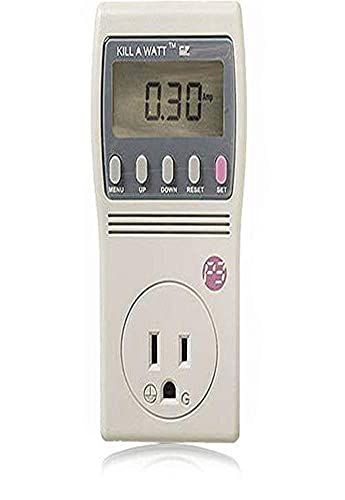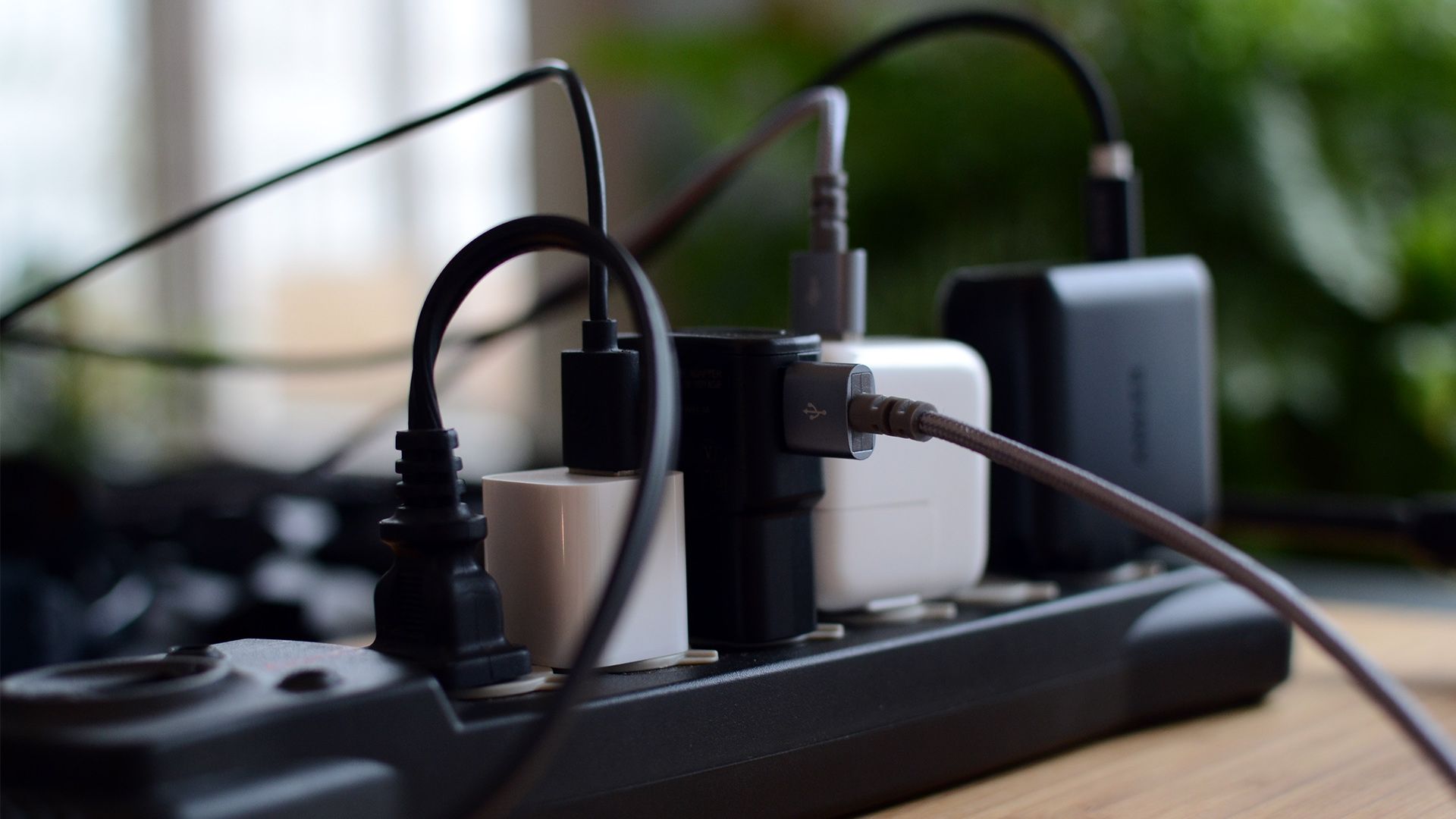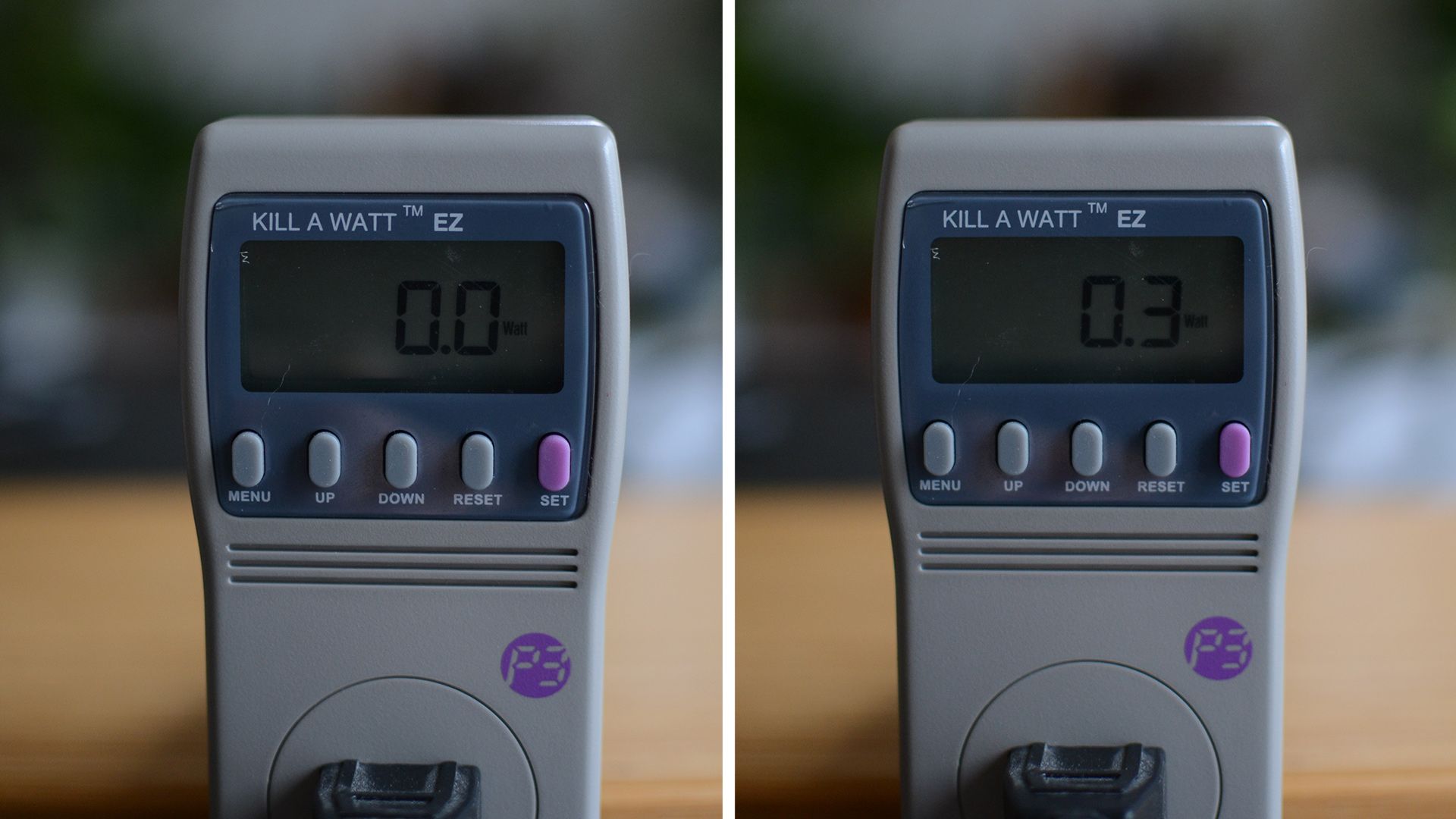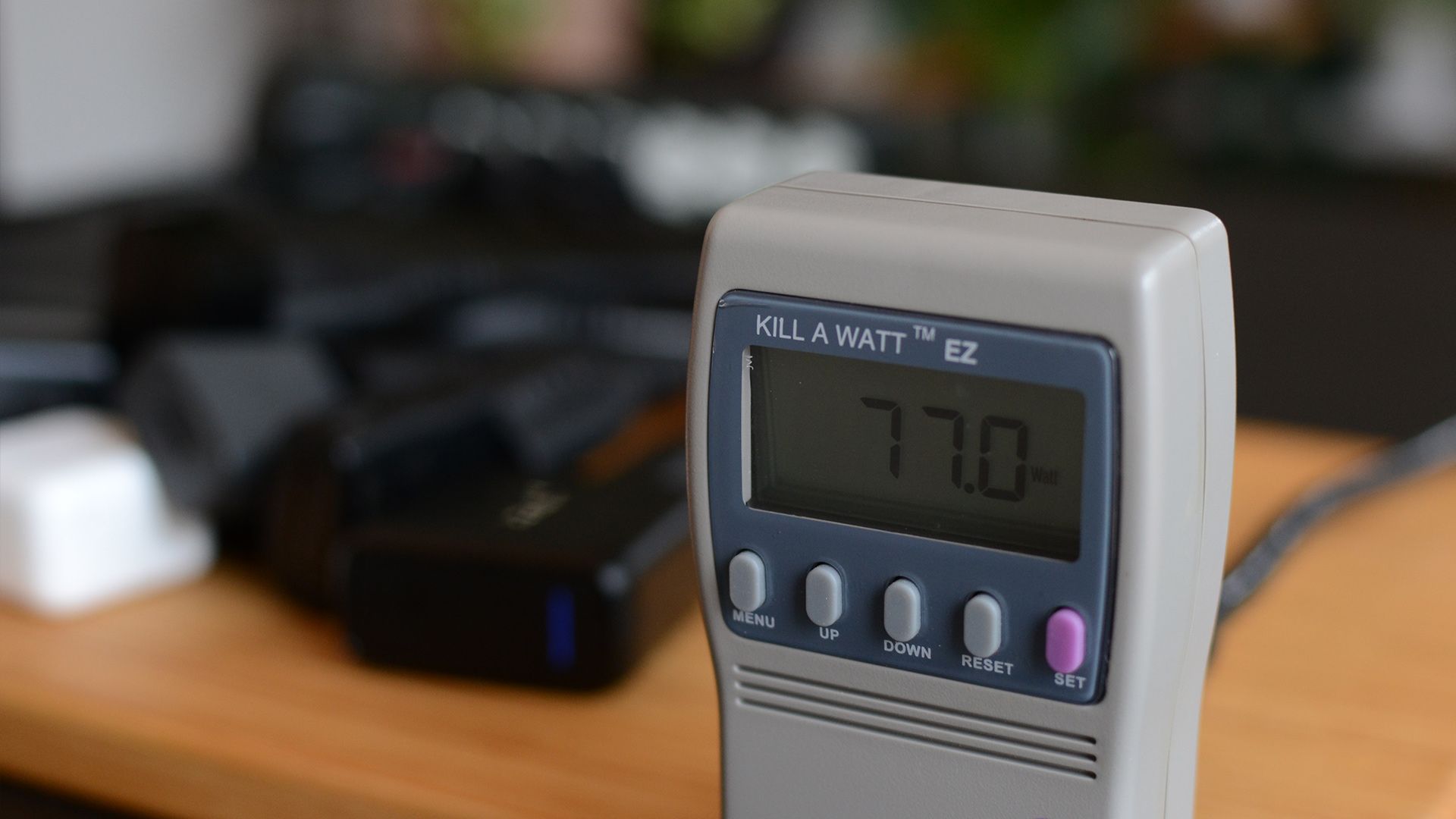Quick Links
Key Takeaways
Smartphone and laptop chargers use a negligible amount of idle power when left plugged in. Other kinds of chargers vary significantly, however, and it's worth checking their power consumption or just unplugging them to play it safe.
How much energy do your smartphone, laptop, and tablet chargers really use? What about laptop and tool chargers? Should you unplug them when you aren't using them to save power and money? We measured exactly how much power a variety of common chargers use---and how much keeping them plugged in will cost you each year.
What We Measured: Charger Phantom Loads
You may have heard the phrases "phantom load" or "vampire power" before in regard to the amount of energy a device uses in standby mode when you aren't using it.
There are a surprising number of energy vampires around the average home, and when people measure how much power common devices use, they're often shocked by how much something like a television uses when nobody is watching it.
With that in mind, you might wonder if you should unplug everything you're not using to save money on your electric bill, including your device chargers. There's no sense in wasting time unplugging your chargers and plugging them back in every day if there is no net benefit, however, so naturally, it's worth testing. There are a lot of myths about batteries and chargers, so we're always happy to conduct tests and make recommendations (like encouraging people to pair a proper charger with their new phone).
How We Measured It (and How You Can, Too)
To measure the phantom load of different common chargers, we used a handy tool named the Kill a Watt power meter.
Not only will the Kill a Watt tell you how much raw energy (in watts) a device uses, but if you take an extra second to plug in how much your local electric company charges you per kilowatt hour (kWh), it'll show you right on the display how much the plugged in device costs you per day, month, and year.
The Kill a Watt and similar consumer watt meters on the market are invaluable tools for measuring things around your home. They use a relatively inexpensive shunt resistor to measure the voltage drop across the resistor to measure the energy consumption of the device plugged into the meter.
We highlight how they work instead of only describing what they can do because Kill a Watt meters and similar devices have trouble resolving a consistent reading below 1W of power consumption. They are designed for general household use and function best and more accurately when measuring devices with power loads above 1W, preferably above 10W. They're great for measuring how much power your computer is using (computers don't waste as much power as you'd think) but not so great for devices with sub-1W power draws.
In instances where you want to measure something with a very low power draw, you need much more sophisticated laboratory-level equipment, or you need to make accommodations to your testing methods (with an understanding that your measurements will not be as accurate as they would be with more sophisticated equipment).
In our case, rather than spending hundreds on an oscilloscope to test cellphone chargers, we used a simple trick to increase the accuracy of our readouts. While conducting the charger tests, we also plugged a 75W incandescent light bulb into the power strip to create a steady 75W draw and stabilize the watt meter. While an imperfect hack, it does increase the accuracy of the shunt resistor's readout by providing a stable higher-watt load.
So if you ever find yourself using a watt meter to measure anything with a low power draw, it's useful to plug in a device with a known fixed wattage output (like a light bulb or a small space heater) and use that to provide a sacrificial load to stabilize the meter. Then you can simply subtract the load of the higher watt item from your readings.

P3 International P4460 Kill a Watt Meter
This inexpensive, reliable device lets you easily measure the power usage of anything in your home.
How Much Vampire Power Do Chargers Use?
With discussion of measuring methodology out of the way, let's dig into the results of our tests and whether or not it's worth unplugging power chargers when you are not using them.
While our tests are not definitive, given the number of different types of chargers across different brands and even decades of manufacture, we feel quite confident our tests are representative of the chargers commonly found in homes and the idle power consumption you should expect from them.
Phone and Tablet Chargers Have Almost No Phantom Load
If you've ever argued with a roommate or spouse about the power bill and how leaving chargers plugged in had no impact, we have great news.
We spent a bit of time in the previous section talking about measuring small electrical loads and the shortcomings of using inexpensive shunt resistors for a reason. It turns out the power draw of a phone charger is so low that it's nearly impossible to even measure without sensitive tools.
We plugged a wide variety of chargers into the Kill a Watt meter, and none, individually, even registered a power draw. This isn't to say that there is zero power draw because the charger does require a tiny, milliwatt level power draw to detect when a device is plugged in and begin the charging process.
But the draw is so unbelievably low that until we plugged in a few chargers, the readout would fluctuate between 0.0 W and 0.3W---a giveaway that there wasn't enough draw present to fully activate the shunt resistor.
Only when we plugged in ten or more chargers at the same time did we get a stable power reading. We loaded a power strip with multiple outlet splitters and then loaded those socket splitters with a variety of regular USB chargers, fast chargers like the kind you would use with your iPhone or Samsung Galaxy phone (and used the light bulb trick we talked about above).
Only then were we finally able to get a consistent 2W difference between the load with just the light bulb and the load with the chargers plugged in.
Again, measuring such low wattage consumption with consumer devices is tricky, but it's safe to estimate a power charger with no attached load (no device plugged in and charging) draws between 0.05W to 0.1W or less of power in standby mode. This series of tests conducted by an electrical engineer with more advanced equipment than ours supports our estimate as he found chargers had a similar range, as does this extensive Department of Energy analysis.
To put that low level of power consumption in perspective, most LED light bulbs use between 5-7 watts of power. So to even approach the power draw of leaving a single energy-efficient LED light bulb on, you'd need to plug in around 100 cellphone chargers.
Laptop Chargers Are Surprisingly Power Efficient
"But what about laptop chargers!" you might be thinking. Surely that big ol' brick of a charger with the blinding LED must waste power. And if you put your hand on your laptop's charging brick while you were charging and felt how warm it got, we can forgive you for thinking it wastes a lot of idle power too.
In fact, we have to forgive ourselves! While we assumed that smaller cellphone and tablet chargers probably didn't waste much energy and merely conducted the test to confirm our assumptions, we also assumed that laptop chargers would prove to be more wasteful, even if only marginally so.
It turns out that global power-saving initiatives like the One Watt Initiative and advances in charger design have had a bigger impact than we realized.
We repeated the experiment by swapping out the cellphone chargers for laptop chargers. It was a mix of giant power bricks for gaming laptops, regular business laptops, and the smaller chargers you find with lightweight laptops like Chromebooks.
Again, it required us to plug multiple chargers in even to get a measurable increase in output. We would have thought a gaming laptop's paperback-book-size charging brick would have at least a modest phantom load. But in our tests, it used no more idle power than a petite cellphone charger.
The only exception to this was when we dug deep into the dusty bins of "just in case" spare parts in our workshop and unearthed some 15+ year-old laptop chargers. A few of the very old chargers did have an idle draw of a few watts. But every newer laptop power brick we tested had a nearly undetectable power draw. We feel confident saying if your laptop was manufactured in the last 10-15 years, the power brick has an idle draw of 1W or lower.
Consider Unplugging Power Tool Chargers
We got into the testing groove and tested a lot of chargers for this article. We failed to find a single cellphone charger with a notable draw. None of the laptop chargers---except for the absolutely ancient chargers---had any notable draw (and even then, it was minor).
The only notable exception we encountered was with power tool battery chargers. Like laptop chargers, there was a variation between old and new chargers, but it was significantly more pronounced.
Just like we found new laptop chargers used barely any idle power, and older ones might use a few watts, we found new power tool battery chargers were equally low-power when idle, but older chargers were often surprising energy hogs when idle.
When we tested the newer regular and "rapid" chargers for our Ryobi 40V lawn and garden gear, for example, despite sporting an LED bright enough to signal passing aircraft, the power consumption was so low that we couldn't measure it effectively (just like the phone chargers).
But the oldest power tool chargers in our workshop (dating back to the late 2000s for older tool sets) drew a noticeable power draw ranging anywhere from 5-10W of power without a battery on the charger. This phantom draw on older power tool chargers is exactly why we noted them in our list of common energy vampires.
How Much Money Does Charger Vampire Power Waste?
It's one thing to know how much energy a charger is (or isn't) wasting, but how does that translate into real-world expenses?
We take a deep dive into how to read your power bill and perform power use/cost calculations in our guide to measuring home energy use, but let's summarize here quickly.
Kilowatt hours (kWh) is a designation of power use over time and how your electric company bills you. You can take any watt value and multiply it by hours of operation and then divide it by 1000 (to convert the watts to kilowatts) to get the kWh value using this formula:
(Watts * Hours) / 1000 = kWh
So for the sake of example, let's say you have five chargers, each using 0.05W of idle power, and you leave them plugged in all the time. The total power draw is 0.25W (5 * 0.05). The kWh used per day is 0.006 kWh and 0.18 kWh per month.
We can then take the monthly value, look up the cost per kWh for your local utility, and then simply multiply the two together.
kWh * Cost per kWh = Operating Cost
The national average cost of electricity in early 2023, per the U.S. Bureau of Labor and Statistics, is 16.8 cents per kWh.
If we take the kWh of our collection of 5 chargers per month (0.18 kWh) and multiply that by the 16.8 cent kWh average cost, we find that our chargers cost us 3.024 cents per month a mere 36.79 cents per year. When you write that out with dollar formatting and round up to the penny, it seems like an even more trivial amount, $0.37.
So you'd need to unplug a dozen chargers every time you weren't using them for an entire year to save around a dollar. In other words, for a single cellphone charger you'd need to it would take over a decade of unplugging your charger every time you were done with it to save a buck.
The only time it makes sense to unplug chargers is in the case of old power tool chargers or other inefficient old chargers that you have tested and found to have substantial phantom loads.
There's no reason to leave a bunch of old power tool chargers plugged in if they collectively suck down 20W of power just idling there. At the end of the year, you'll have spent about $30 on absolutely nothing.
Instead of Worrying About Your Chargers, Do This Instead
If you've read this far, it's safe to say you're probably pretty passionate about saving money on your electric bill, cutting down on electrical waste out of a sense of environmental stewardship, or both.
So if unplugging your cellphone and laptop charger has nearly zero impact on your electric bill and a practically microscopic environmental impact, what should you do instead?
Unplugging things isn't without merit. Just focus on identifying devices with a substantial phantom load. You know that old TV and cable box in your seldom-used guest room or the den? There's a good chance the idle power consumption for the never-watched TV setup is around 40W. Leaving them plugged in 24/7 is like leaving a modest incandescent light bulb on all the time. You'll end up wasting around 90-100 kWh a year on nothing and spending $15-16 for the privilege.
And if there are things you want to leave plugged in for convenience but you want to avoid wasting power, consider using smart plugs or smart strips to manage the power use. You can turn the strip or plug off when you aren't using all the items plugged into it, but you avoid having to crawl behind the entertainment center to plug anything in when needed.
Speaking of entertainment centers, computer desks, and other places in your home that have a lot of things plugged in (often in very inconvenient locations). You might want to skip using a smart power strip and use a "power sensing" power strip instead.
Power sensing strips detect when the main device is on (such as your TV or computer) and when it is off. When the primary device is off, the strip cuts power to all the other devices. This way, when you turn the computer or TV off at the end of the day, all the peripheral outlets are turned off (stopping the vampire energy drain in the process).
Or if all of that seems too fussy, switch out any old incandescent bulbs you have still to LED bulbs. The energy use and cost of LED bulbs are so low, we've jokingly suggested you can stop worrying about turning the lights off. Swapping out a single frequently used incandescent bulb to an LED bulb will save so much energy over a year that it won't just cancel out the small amount of vampire power your chargers waste, it will likely cancel out the cost of charging all your devices too.



